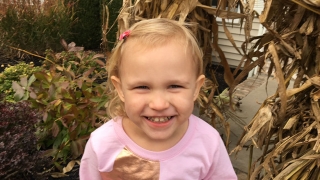It is 10 p.m. In the Pediatric Intensive Care Unit (PICU), Lara Weems stands in a darkened room, rocking her 9-month-old son, Carter, in her arms. She sings, coos and all but begs him to get some rest. Her husband, Aaron, circles the room. It has been 10 hours of waiting with a singular focus: Is the liver good?
Carter was born with ornithine transcarbamylase (OTC) deficiency, a rare metabolic disorder in which the liver can't rid the body of ammonia. Just a few hours of ammonia buildup can cause permanent brain damage in a newborn, even send him into a coma. The littlest thing can trigger an ammonia spike: any illness, too much food, too little food, missed medication, throwing up his food or medication.
 Carter and Lara Weems
Carter has spent five of his first nine months at CHOP and must be fed and medicated every three hours around the clock. To avoid germs that might make Carter sick, the family has become virtual shut-ins.
Carter and Lara Weems
Carter has spent five of his first nine months at CHOP and must be fed and medicated every three hours around the clock. To avoid germs that might make Carter sick, the family has become virtual shut-ins.
"We have just gotten to know this sweet baby, and it's an ever-present looming stress that if we make one wrong move, we might lose him," says Lara. For Carter to survive without serious brain damage — perhaps even to survive at all — he needs a liver transplant.
With it, he would be cured.
The wait for the right liver
The Fred and Suzanna Biesecker Center for Pediatric Liver Disease, established 10 years ago thanks to a gift from the Biesecker family, has made CHOP one of the best places in the world for kids like Carter.
After two months on the transplant list and one false alarm — the family spent all night at CHOP only to learn that the donor liver wasn't suitable — a potentially compatible liver from a deceased child has become available. It would make Carter one of about 15 children who receive a new liver at CHOP each year.
Behind the scenes, Kate Anderer, Carter's transplant coordinator at CHOP, thinks it's looking good. She has been on the phone all day with the organ procurement organization, relaying information between the teams and parents, and waiting to find out exactly when the donor surgery will take place.
Around midnight, with two CHOP surgeons in the operating room (OR) at the donor's hospital to collect the new liver, Anderer gives the green light for Carter to relocate from the PICU to CHOP's OR complex. He is the only patient in the OR that night. For an event this momentous, it is a long, quiet wait.
At 1 a.m., the OR nurse walks in with a cordless phone.
"The transplant coordinator wants to talk to you," she says. Lara signals her husband to take the phone. She's sure it's bad news and doesn't want to hear it.
"It's good?" Aaron says into the phone. "That's great news."
Lara's jaw drops in astonishment. She closes her eyes, as they well up with tears, and bends over her son, who is asleep in his crib. Both parents kiss Carter and whisper goodbye as the nurse wheels him into the OR.
"I promise I'll take good care of him," says the nurse as the parents head to the empty family waiting room, thrilled but slightly numb with disbelief.
Carter's life-saving surgery
At 2:29 a.m., surgeon Kim Olthoff, MD, begins the process of removing Carter's liver. Minutes later, another surgeon walks briskly into the OR carrying a cardboard box bearing bright orange and green stickers: "Human Organ/Tissue for Transplant." She unpacks the new organ from layers of ice and protective fluid and, with the other lead surgeon, Abraham Shaked, MD, PhD, begins preparing it for Carter.
The surgeons work with a calm intensity. The tiny blood vessels of a 9-month-old make for complicated microsurgery, but Olthoff and Shaked are among the most experienced transplant surgeons in the country. Between the surgeons, nurses and anesthesiologists, there are as many as 10 people in the OR. The nurses record every detail, counting every gauze pad and instrument, ensuring that nothing is left in Carter's abdomen.
At 4 a.m., Carter's old liver is out and another doctor arrives to collect samples of it for routine testing and research. Meanwhile, the new liver is placed into Carter's abdomen and attached to his vessels and ducts.
At 7:15 a.m., Olthoff enters the waiting room. Aaron is napping in a chair, his wife curled up with hospital blankets on the floor. They awaken, rumpled and bleary-eyed but anxious to hear the news.
"The liver looks good," Olthoff tells them. "It was a perfect fit, like it was meant to be his." Lara throws her arms around the doctor, who looks slightly shocked — she has been on her feet operating all night.
Time will tell how the early ammonia exposure will affect Carter in the long run, but two months after the transplant, his liver is functioning well and even the long frown of a scar across his abdomen has healed.
"Carter seems like a different kid," says Aaron. "Now that he's not in constant discomfort, he has the chance to calmly and independently explore the world. In some ways it's like starting over as a newborn. It's a whole new phase of his life."
Originally posted: November 2011

